Steeped in a savory dashi broth, Japanese Spinach Salad uses a simple method called ohitashi to infuse the greens with subtle umami flavor. It‘s one of the classic Japanese cooking techniques used to prepare vegetable side dishes. {Vegan Adaptable}
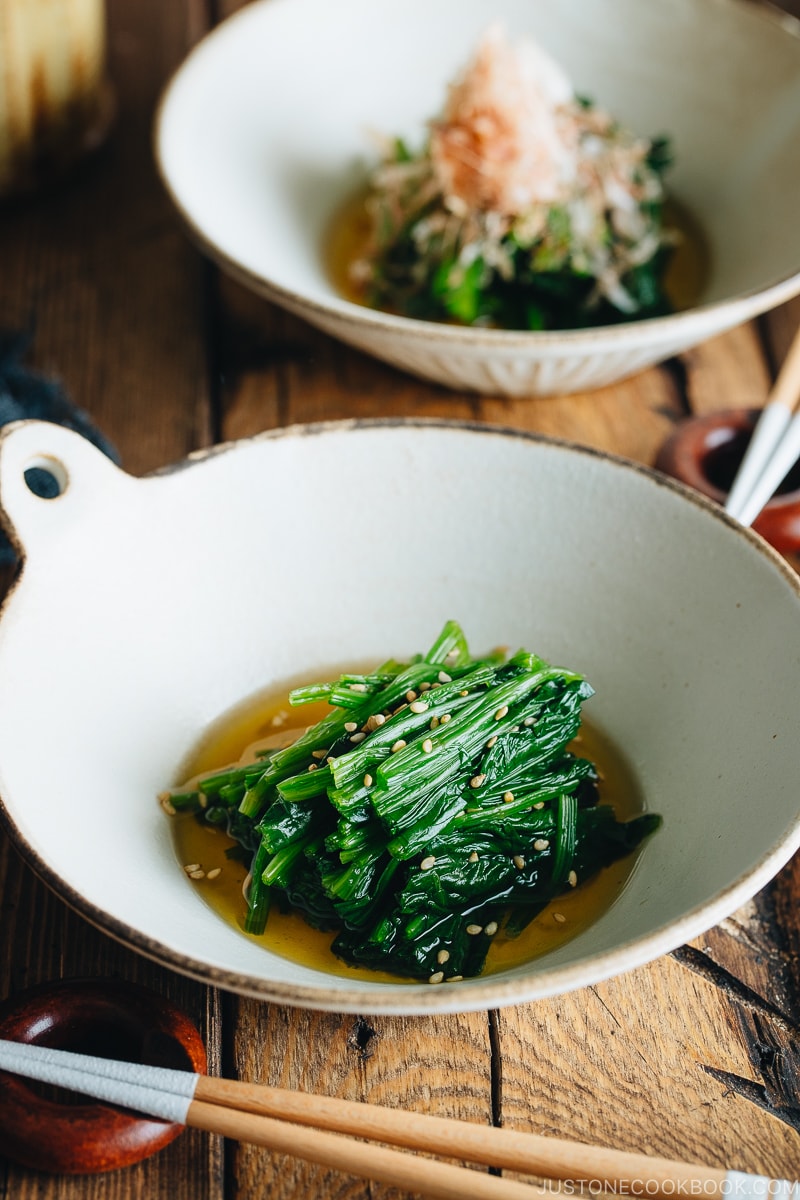
Do you know what type of recipes Just One Cookbook readers request most? They are side dishes and vegan recipes! Today, I’m happy to introduce a classic Japanese side dish with a vegan-friendly option!
My recipe for Spinach Ohitashi (ほうれん草のお浸し) is a Japanese spinach salad with a savory broth. This recipe uses a simple method called ohitashi that’s of the classic Japanese cooking techniques for vegetable side dishes. I think you’ll love this dish and I can’t wait for you to try it at home.
Table of Contents
What is Ohitashi?
Ohitashi (お浸し) refers to a dish in which vegetables are steeped in a dashi-based sauce. It’s a common Japanese cooking technique we use for preparing vegetable dishes. This method infuses the ingredients with the Japanese soup stock’s umami and subtle flavor but still retains the vegetable’s natural taste.
To make ohitashi, you first blanch the vegetable, then halt the cooking in an ice bath. Afterward, allow the vegetable to absorb the dashi-based sauce.
We typically serve ohitashi with a sprinkle of katsuobushi (dried bonito flakes) on top. For today’s recipe, I included a vegan-friendly version:
- Vegan-friendly version: Use vegan-friendly Kombu Dashi for steeping and garnish with toasted sesame seeds instead of katsuobushi.
- Regular version: If you prefer a more prominent dashi flavor, use Awase Dashi, a combination of both kombu and katsuobushi.
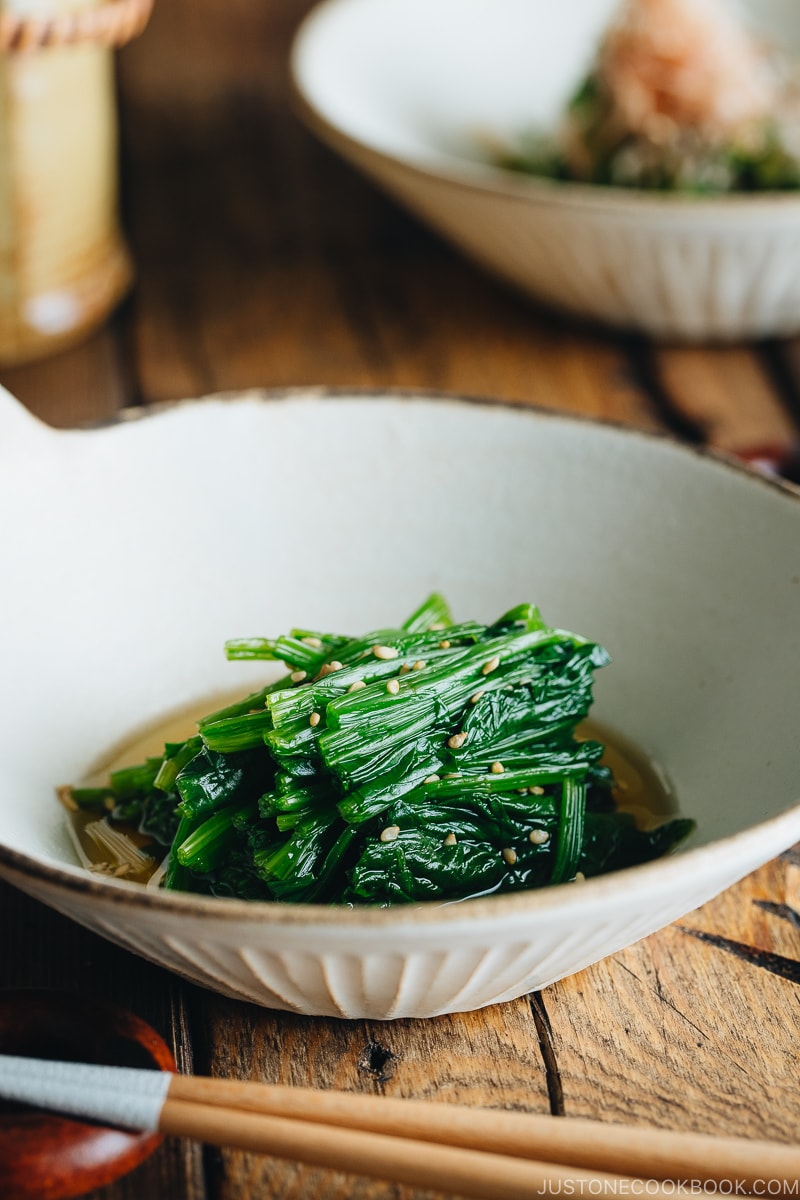
Ingredients for Spinach Ohitashi
- spinach
- Diamond Crystal kosher salt
- water – or you can use awase dashi or vegan dashi and skip the kombu
- kombu (dried kelp) – or substitute a dashi packet or powder
- mirin (Japanese sweet rice wine)
- usukuchi (light-colored) soy sauce
- katsuobushi (dried bonito flakes) – for garnish; skip for vegan/vegetarian
- toasted white sesame seeds – for garnish
How To Make Spinach Ohitashi
- Make the savory broth by boiling the dashi, mirin, and soy sauce. Turn off the heat and set aside to cool.
- Cook the spinach for roughly 1 minute in a large pot of boiling water with a pinch of salt. Start with the stem end; after 15 seconds, push down the leafy part into the boiling water.
- Remove and cool in an ice bath.
- Squeeze out the water from the spinach.
- Cut the spinach into 1½-inch (3.75-cm) lengths.
- Soak the spinach in the broth in an airtight container for 1–4 hours.
- Serve in small individual bowls and pour some broth on top. Sprinkle with sesame seeds and katsuobushi (dried bonito flakes) on top (skip for vegan/vegetarian).
Spinach ohitashi keeps in the refrigerator for up to 3 days.
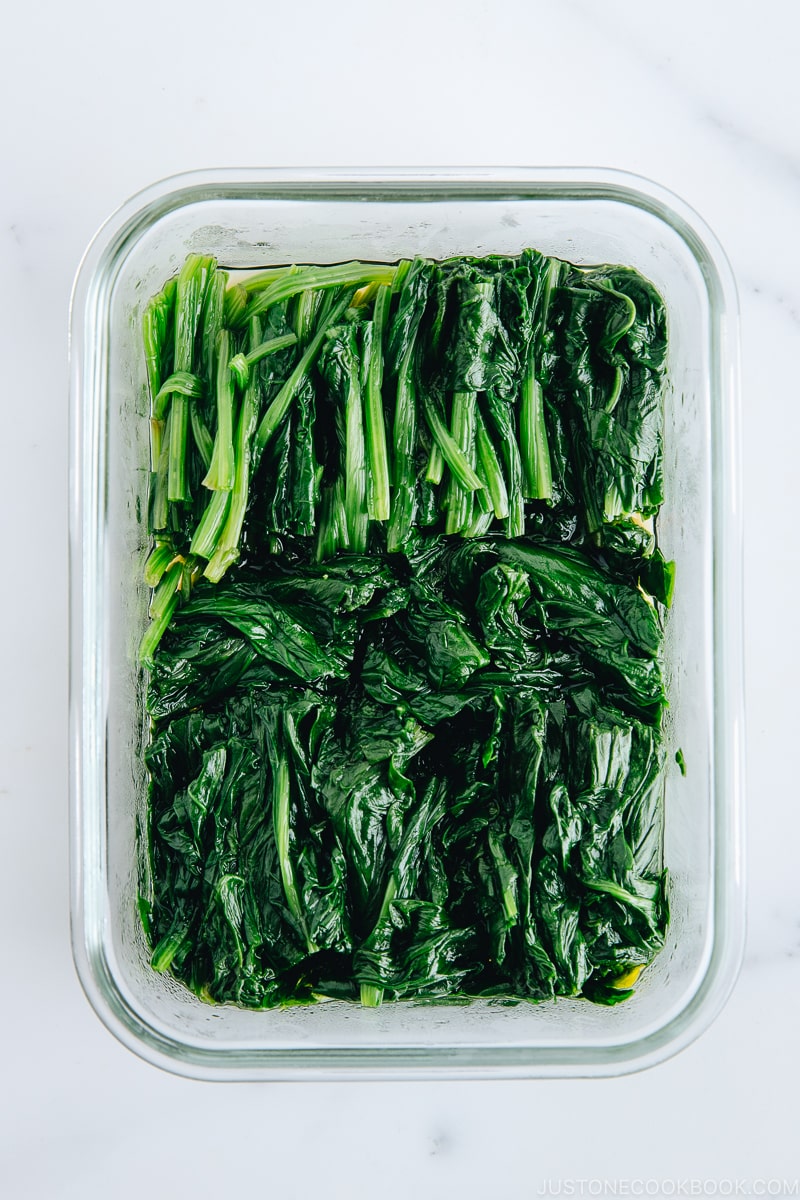
Serve Spinach Ohitashi with Your Japanese Meal
A typical Japanese meal consists of steamed rice, miso soup, main dish, and side dishes. This set meal is called ichiju sansai (一汁三菜) and you can read more about it in my detailed post.
A Japanese set meal encourages you to eat a balanced diet. You’ll find each dish presented in individual serving dishes. Side dishes are usually in a kobachi (小鉢, literally meaning “small bowl”). As a result of this attentive arrangement, we can easily control the portion of the food.
Here are a few suggestions that I would serve with spinach ohitashi:
Rice
Miso Soup
Main Dish
- Eggplant Miso Dengaku
- Warm Mushroom Salad
- Mapo Tofu
- Grilled Mackerel
- Nikujaga (Meat and Pork Stew)
- Baked Tonkatsu
- Teriyaki Steak Rolls
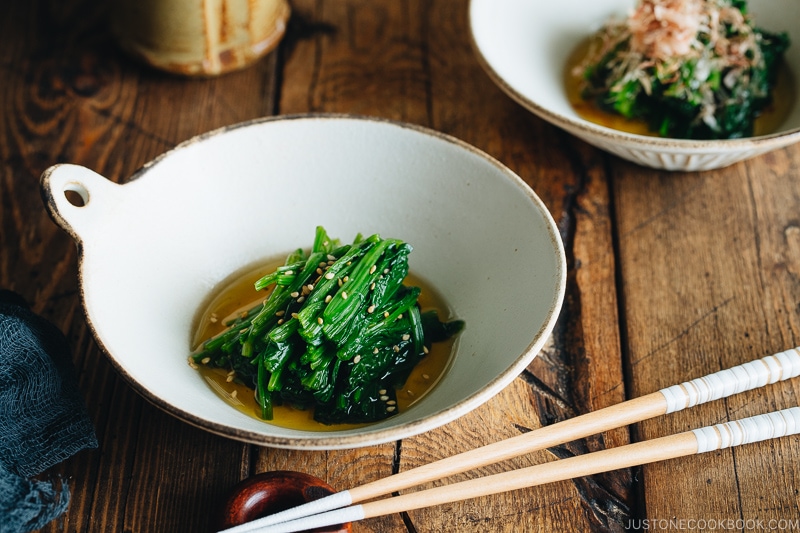
Side Dishes
- Chilled Tofu
- Hijiki Seaweed Salad
- Kinpira Renkon (Stir-Fried Lotus Root)
- Simmered Kabocha
- Kinpira Gobo (Stir-Fried Burdock Root)
- Spinach Gomaae (Spinach Salad with Sesame Sauce)
Ohitashi is Great for Meal Prep!
Since ohitashi is made ahead of time, it makes a perfect side dish for meal prepping. In general, you can steep the vegetables in the dashi soy broth for 3 days.
If you have 20–30 minutes to spare, prepare your vegetables and let them absorb all the flavor as you store in the refrigerator. Use a clean utensil and container and put it in the refrigerator as soon as the food is cool. This allows the food to last longer.
For more inspiration for make-ahead recipes, visit my Meal Prep page.
Different Vegetables To Try
You can apply the ohitashi method to almost any kind of vegetable! If you are not a fan of spinach, try:
- okra
- eggplant
- boy choy
- other leafy greens
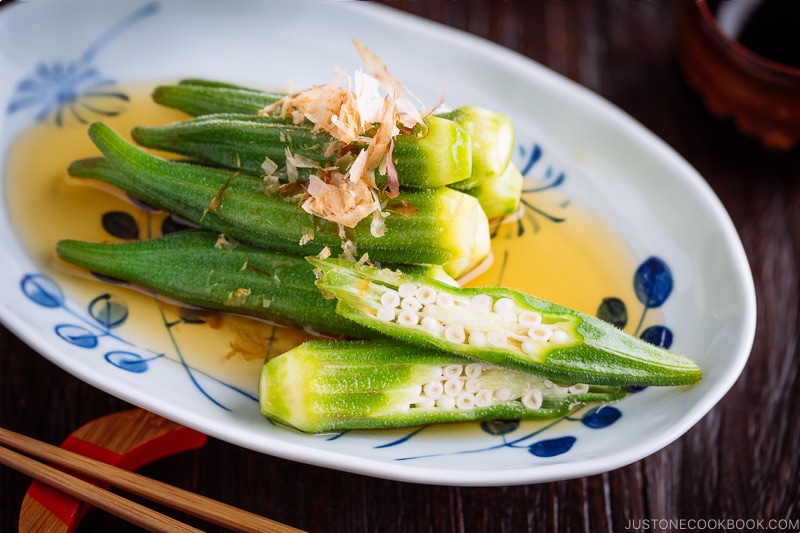
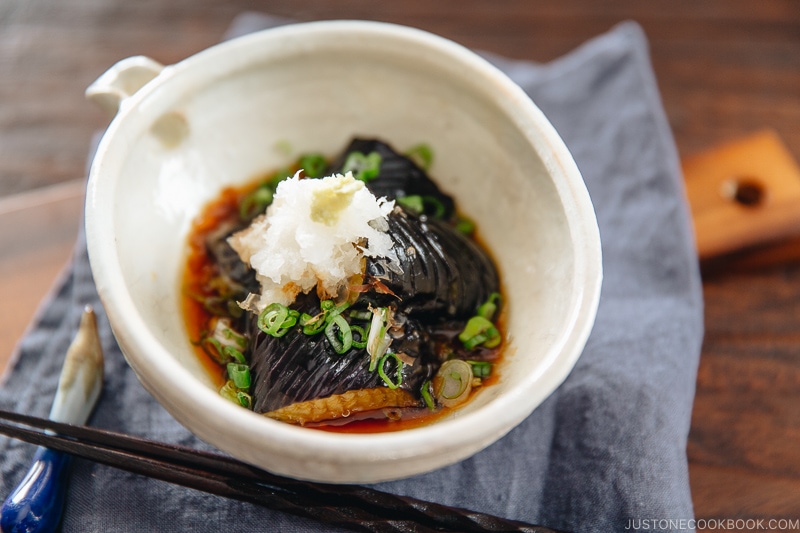
Eggplant Agebitashi (variation of Ohitashi)
Wish to learn more about Japanese cooking? Sign up for our free newsletter to receive cooking tips & recipe updates! And stay in touch with me on Facebook, Pinterest, YouTube, and Instagram.

Spinach Ohitashi (Japanese Spinach Salad)
Ingredients
For the Kombu Dashi
- ½ cup water (or use Awase Dashi or Vegan Dashi and skip the kombu)
- 1 piece kombu (dried kelp) (5 g; 2 x 2 inches or 5 x 5 cm per piece; or substitute a dashi packet or powder)
For the Seasonings
- 1 Tbsp mirin
- 1 Tbsp usukuchi (light-colored) soy sauce
For the Spinach
- 1 bunch spinach (8 oz, 227 g)
- 1 pinch Diamond Crystal kosher salt
For the Toppings
- katsuobushi (dried bonito flakes) (skip for vegan/vegetarian)
- toasted white sesame seeds
Instructions
- Before You Start…Please note that this recipe requires at least one hour of soaking time. Gather all the ingredients.

To Make the Kombu Dashi
- In a saucepan, put ½ cup water and 1 piece kombu (dried kelp).
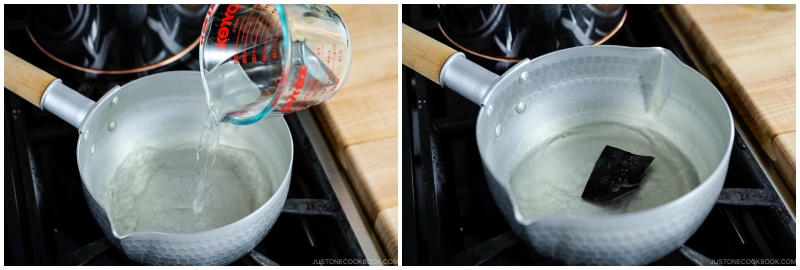
- Slowly bring it to a boil. Once boiling, remove the kombu from the liquid (and reserve it to make Kombu Tsukudani). Now, you have kombu dashi. If you are not vegan/vegetarian, you can add a small amount of katsuobushi for more flavor (see my Awase Dashi recipe for instructions).
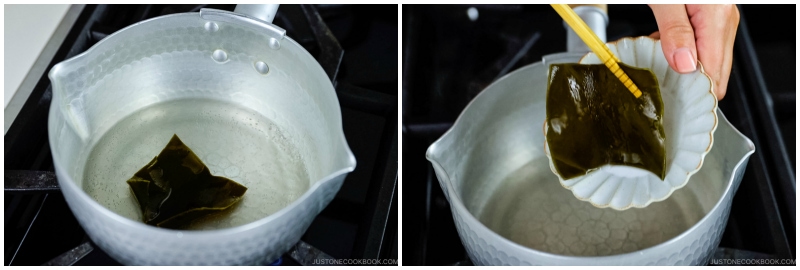
To Make the Savory Broth
- To the dashi, add 1 Tbsp mirin and 1 Tbsp usukuchi (light-colored) soy sauce.
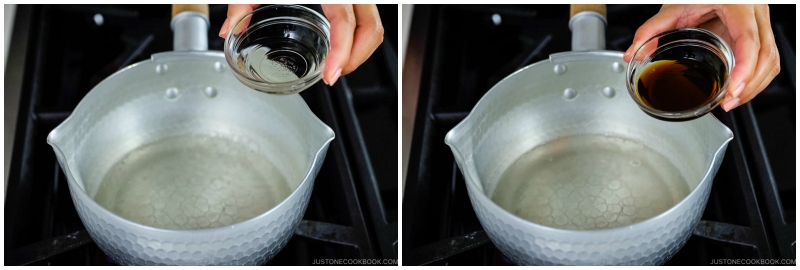
- Mix together, bring to a boil, and turn off the heat. Set aside.
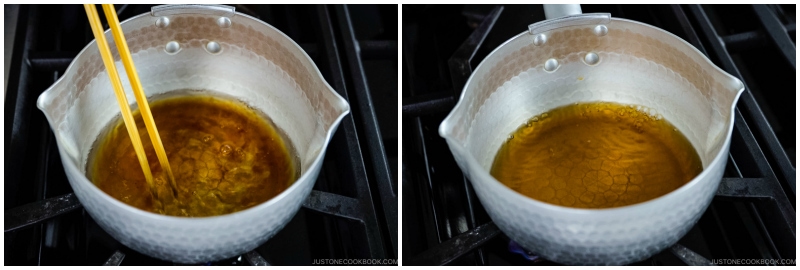
To Prepare the Spinach
- Rinse well 1 bunch spinach.
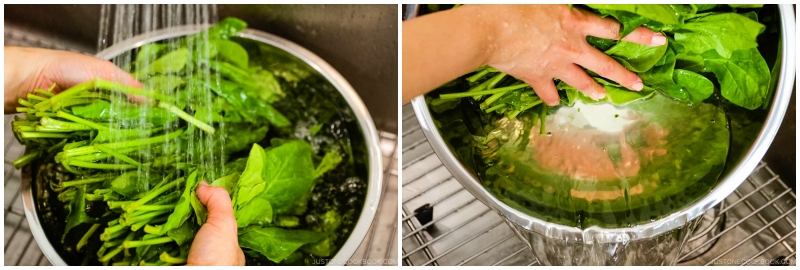
- Bring a large pot of water to a boil. Once boiling, add 1 pinch Diamond Crystal kosher salt. Add the spinach to the boiling water stem side first since the stems take longer to cook.
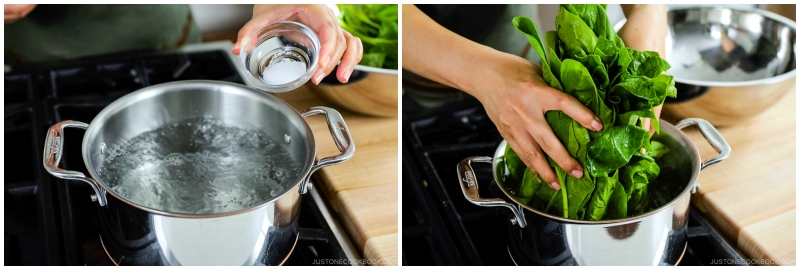
- After 15 seconds, push down the leafy part into the water and cook for up to 1 minute. (Spinach in the US is more tender than Japanese spinach, so it cooks faster.) Once the spinach is cooked through in roughly less than 1 minute, remove it quickly from the boiling water.
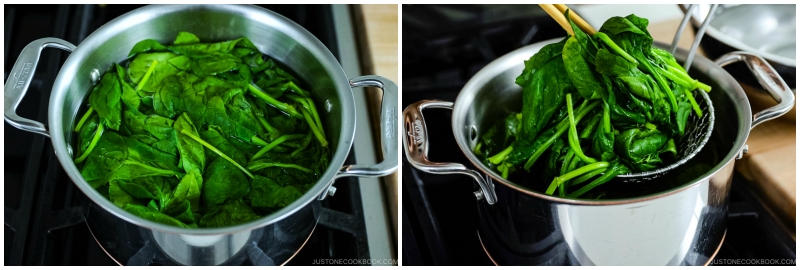
- Transfer to a bowl of iced water and let it cool (but don’t leave the spinach too long, as it will lose nutrients).
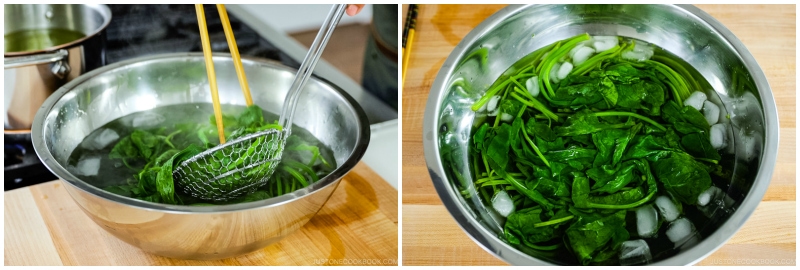
- As soon as it‘s cooled, collect the spinach and squeeze out the water. If you like to serve this dish as I do, gather together the spinach neatly by the stems. I like to serve both the stem and leafy parts separately instead of mixing it up together.
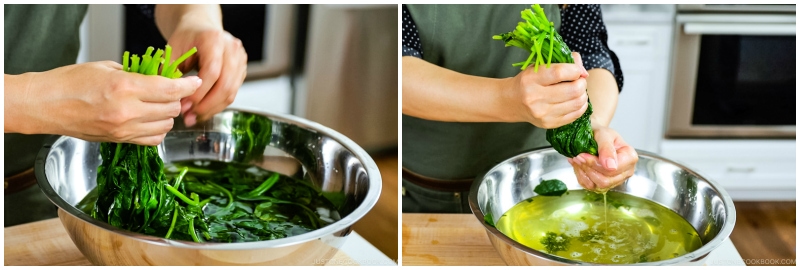
- Cut the spinach into 1½-inch (3.75-cm) lengths and squeeze the water out one more time.
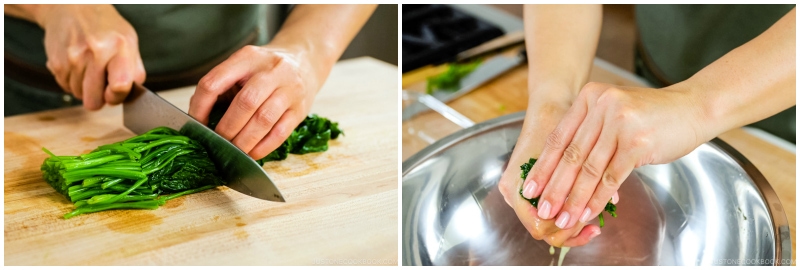
To Soak in the Broth
- Put the spinach in an airtight container. Now, pour the savory broth over the spinach.

- Make sure the spinach is evenly distributed in the container and fully submerged in the broth. Put the lid on and let it soak in the refrigerator for at least 1 hour and ideally up to 3–4 hours.

To Serve
- Serve the spinach in small individual bowls and pour some broth on top. I like to make sure each bowl gets both the stem and leafy parts. The dark and light green color contrast makes a beautiful presentation.
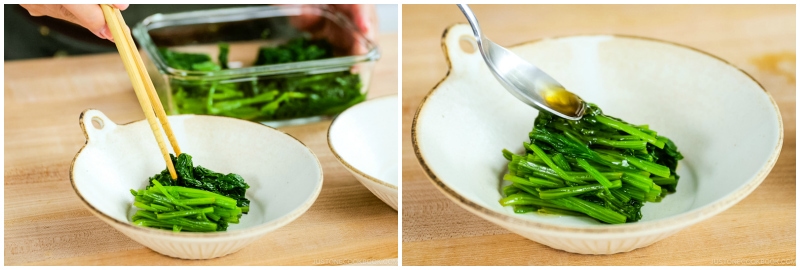
- Sprinkle with toasted white sesame seeds for a vegan/vegetarian version. For the standard version, add katsuobushi (dried bonito flakes) on top. Enjoy!

To Store
- You can keep Spinach Ohitashi in the refrigerator for up to 3 days.
Nutrition
Editor’s Note: This post was originally published on January 26, 2012. It’s been updated with a new video on September 2019.
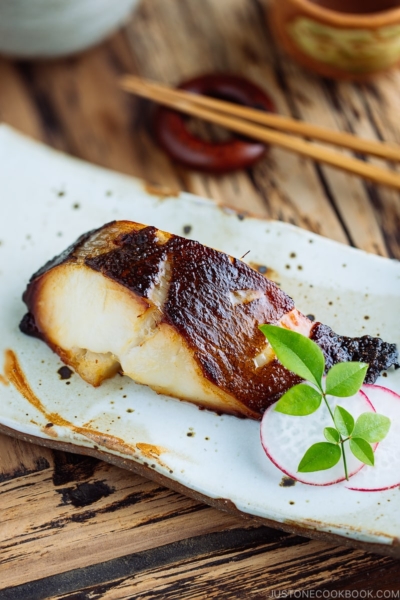
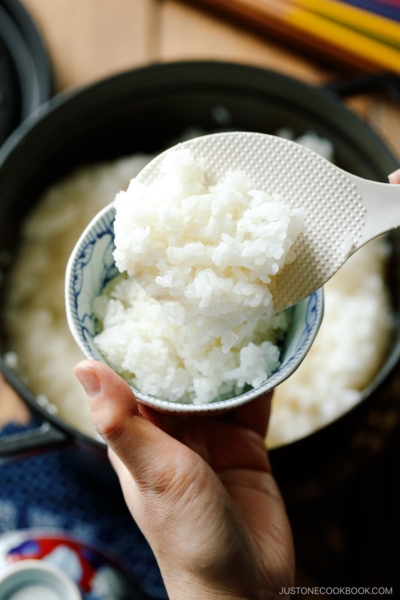
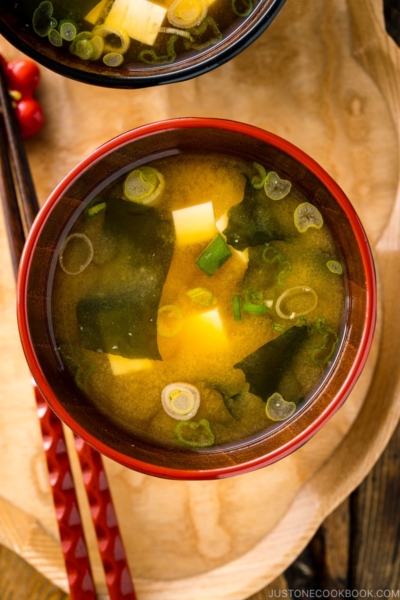
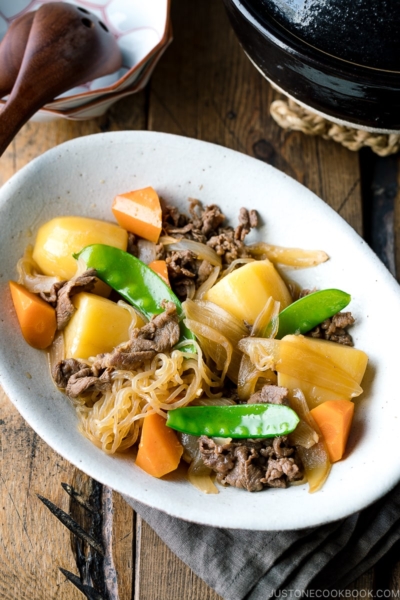




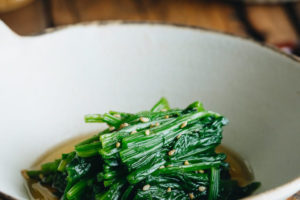
I’ve got to try this! I think I’ve bought every one of your ingredients Amazon had to offer! One question, where did you get that dimpled sauce pan?
Hi Lisa! Thank you so much for reading Nami’s post and trying her recipe!
It’s called Yukihira Nabe, and you can get the same one from this link: https://www.amazon.com/dp/B001BASSR0?linkCode=ssc&tag=onamzjusoneco-20&creativeASIN=B001BASSR0&asc_item-id=amzn1.ideas.2R2UR0OTHR4WB&ref_=aip_sf_list_spv_ofs_mixed_d_asin&th=1
We hope this helps!
For other items: https://www.amazon.com/shop/justonecookbook
😊
Making again. Simple recipe with a ton of flavor. Used baby spinach and it turned out just fine. Dachi did not make as much liquid as I thought it would.
Hi Susan! We are so happy to hear you enjoyed Spinach Ohitashi!
Thank you very much for trying Nami’s recipe and for your kind feedback!
Hello! Thank you for sharing this wonderful recipe!
A few questions:
1) Can I use Chinese spinach for this recipe?
2) After soaking the spinach for a few hours, do I have to drain the spinach and change the container to store it for a few days?
Hi Adeline! Thank you very much for trying Nami’s recipe!
1) Yes, you can use Chinese spinach for this recipe!
2) You do not need to drain them. Instead, you can store it together in a container for a few days.
We hope this helps!
I was wondering, when you store it, is it stored in the liquid or no liquid? I thought maybe I could meal prep this but I’m not sure if it’s better to just make the same day.
Hi Christy! Thank you for trying Nami’s recipe!
The Ohitashi usually can be stored for up to 3 days if you keep them in an airtight container in the refrigerator. However, after a few days, the food quality would change. We recommend storing the cooked spinach and liquid/sauce separately and pour the sauce over on the serving day if you plan for meal prep. You can also freeze the cooked spinach so that you can keep them longer. https://www.justonecookbook.com/basic-freezing-techniques/
We hope this helps!
Can I use musubi nori instead of kombu? I can’t find it where I live, very small town.
Hi Lynn, The musubi nori and Kombu are different, and we don’t recommend using them for making Dashi.
How about use Shiitake to make Dashi? https://www.justonecookbook.com/shiitake-dashi/
We hope this works.
We eat this SO often. I’ve made it several times as written with great results. However, produce is not great in my town (northern rural Canada) and we only get very expensive baby spinach. So I started using kale and just cooking it a bit longer. For anyone wondering, it turns out very well also!
Do you have a sweetish dressing for the same?
Hi Anu, You may add sugar to this recipe as much as you like. We hope this helps!
can this be soaked for several days? if not being consumed for 2-3 days? I see it says it lasts up to 3 days but just want to make sure it’s safe to be soaking for that long.
Hi Helen, Thank you very much for trying this recipe. The Ohitashi usually can be stored for up to 3 days if you keep them in an airtight container in the refrigerator. However, after a few days, the food quality would change, so we recommend enjoying it within 2~3 days. We hope this helps!
I’m so happy to have found your site. This was delicious!! Cannot wait to try more of your recipes.
Hi Anita, We are so glad to hear you enjoyed this Spinach Salad! Thank you very much for trying this recipe and for your kind feedback.
Thank you for this recipe. I’m cooking for my Japanese mother-in-law. And this is one of her favs. I love it too!
Hi Carolyn! I’m so happy to hear that you and your MIL likes this recipe. Thank you for your kind feedback!
I have made this multiple times with Rainbow Chard instead of spinach. It is delicious and I really enjoy the texture of the blanched chard with the Ohitashi. Plus the stalks add some great visual color and a little bit of crunch.
Hi Lindsay! Oh yes, I love the rainbow chard ohitashi and how beautiful the color gives/adds to the dish! Thank you for sharing the idea! I’m so glad you enjoyed this dish!